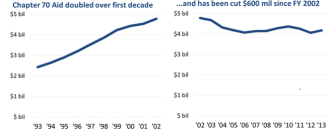When I interviewed Superintendent of Public Instruction Tom Torlakson as part of our coverage of the state chief’s race he mentioned California’s relatively low per-student spending as a reason why Golden State students continued to lag behind their counterparts elsewhere. He highlighted Massachusetts (among others) as a state he said spends a higher and more appropriate amount per student on K-12 and has strong academic results to show for it.
So it’s noteworthy that for the first time in about 15 years, Massachusetts lawmakers will review the state’s landmark Education Reform Act of 1993 to consider significant changes to how school funding works in the Bay State. In the fiscal 2015 budget, state legislators revived a budget commission to look at how education spending works and began meeting earlier this month, the Boston Globe reported.
In its “Quality Counts” report for 2014, Education Week ranked Massachusetts 14th in terms of per-student spending, using 2011 figures. However, among states with highly ranked school finance systems, we noted that Massachusetts was using only 3.6 percent of its taxable resources on education, the lowest of the top 14 states in terms of their “Quality Counts” grade regardinG their K-12 finance systems.
Many are hoping that a new formula will bring a significant boost to spending. The Massachusetts Budget and Policy Center, for example, notes that for the first several years after the Education Reform Act was passed, basic aid in the state’s funding formula (called Chapter 70 spending) rose steadily, but then leveled off and has been idling its motor for some time:

The formula has lagged particularly badly when it comes to accounting for districts’ special education costs, as well as employee health care benefits, according to the group: “While Ed Reform established a new funding mechanism in 1993, the state has made few mid-course adjustments during the intervening twenty years, ultimately hampering many districts’ ability to make direct classroom investments outlined in the original foundation budget.”
One local school board member, Nancy Gallivan, described her district’s need for a new perspective on resources to the Globe this way: “When the law first took effect in 1993, in our district we were fund-raising to get a few computers into every classroom. But now you could not have classrooms without Internet capacity.”
